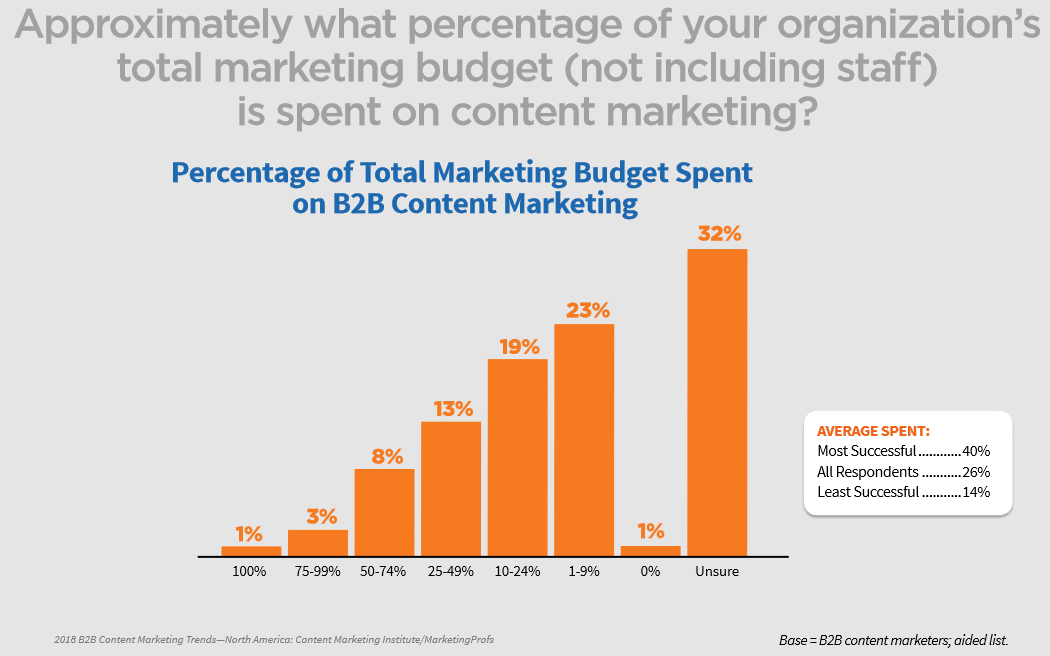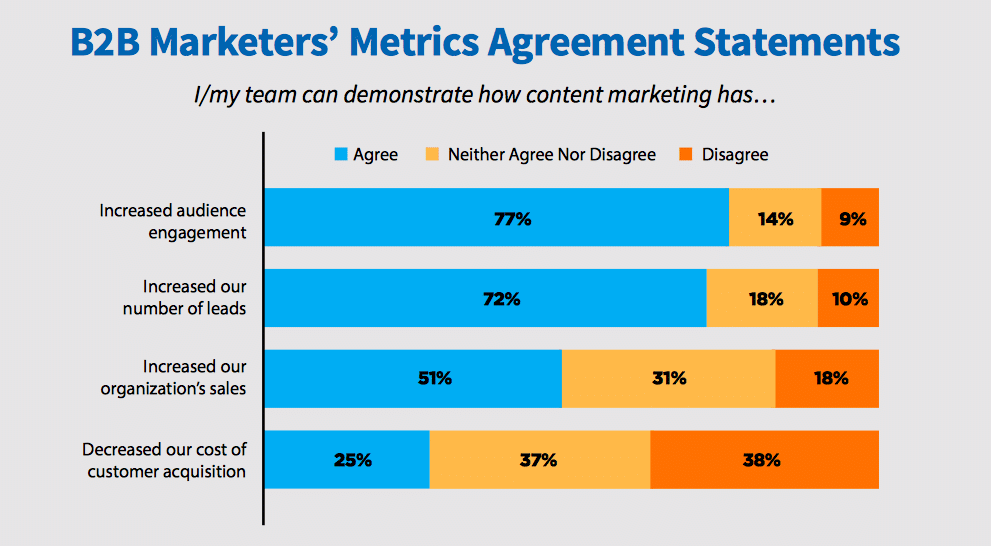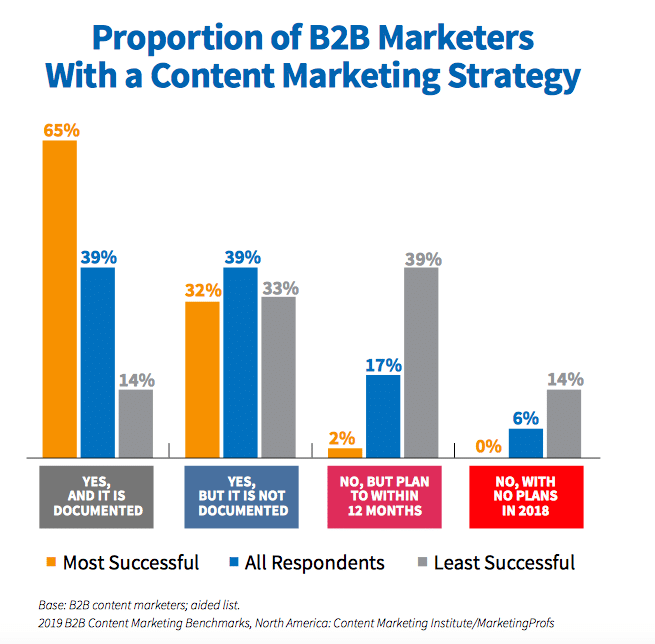
How to Gain Buy-In for Content Marketing
You know how powerful content marketing is for brand awareness, lead nurturing, and building lasting relationships with your customers. So do the 91 percent of B2B marketers (per CMI) who are using content marketing today.
But, chances are, your organization’s executive team isn’t as excited about your content marketing efforts as you are. While content marketing budgets have been blossoming in recent years – the industry is expected to reach $300 billion by 2019 – in-house marketing professionals still struggle to get the support they need.
It’s not just about securing the budget and resources you need. Just as important are factors like:
- Internal cooperation across departments
- Room to experiment and make mistakes without fear of your content marketing budget getting slashed
- The engagement of the company’s internal experts – bringing employees into your content marketing strategy is a rising trend in content you don’t want to get left behind on
So, how can you get the internal buy-in for content marketing?
Why Getting Executive Buy-In for Content Marketing Can Be Challenging
As a marketer, you already know that content marketing is well worth your time and effort. What you put in is almost guaranteed to be returned to you many times over, and this attractive ROI combined with low costs and barriers to entry makes content marketing one of the most popular marketing strategies for businesses large and small.
However, it’s not always so easy to convince management and C-suite that content represents a worthy investment. Unlike traditional advertising campaigns and other types of marketing, it can be quite some time before you see the results of your content marketing campaign.
In some cases, it might take years before you build enough momentum from your content marketing activities to see real results. But only 59% of respondents surveyed by the Content Marketing Institute agreed that leadership offered enough time to demonstrate content marketing results. So how can you get executive buy-in if you’ve only got a short timeframe to prove its effectiveness?
There are actually several reasons why executives don’t immediately see content marketing as the same amazing opportunity that marketers do.
Remember, the aims of your role in the company are fundamentally different. Marketers want to raise brand visibility and generate leads, while C-suite is concerned with the overall strategic running of the business and generating income. It may not be immediately obvious how content marketing fits into this.
The main challenges or sticking points include:
- The ROI of content marketing is difficult to measure and prove.
- Results from content marketing may not be seen until months or years later.
- Producing enough content to be effective either means investing in more staff or outsourcing costs, or taking employees away from other activities.
- Content marketing is a fairly new strategy compared to more traditional marketing methods and senior level employees are therefore less likely to understand it fully and be familiar with the techniques involved.
To get executive buy-in, you need to prove the worth of content marketing in facts and figures so it’s not dismissed as just being the latest trendy tactic that doesn’t necessarily produce results.
Start with a Strategy
To convince your customers they will benefit from your product or service, what’s always your first step?
You have to educate your buyers about the value of what you are selling with a smart content strategy. Take this same approach when selling content marketing to your organization’s decision and budget makers.
Educate them on the importance of content marketing – with content.
So, get in the shoes of your audience just like you would when you create your buyer personas.
- What are the pain points, hesitations, and goals of your organization’s executive team?
- What information – relevant statistics, industry examples, in-house content analytics – do they need to see to understand the value of your content marketing?
- What channels will resonate the most, for example, what presentation format will work? How can you quickly update upper management on the worth of your content with ROI analytics on an ongoing basis to keep them motivated?
- When are they going to be the most open to paying attention?
The secret to gaining buy-in for content marketing is to demonstrate its worth with a solid strategy rather than a pile of stats and examples that aren’t really connected. Think through how all the information you present builds your case and works together to make your point.
Here’s what you may want to include in your strategy.
Show the Potential of Content with Examples
Don’t expect every member of your organization’s leadership team to fully understand just how intense and dynamic content marketing can be, or even how it works.
There are still people who assume content marketing starts and ends with blog articles and social media, which makes it difficult to be inspired by your content marketing efforts or to be motivated enough to up your budget or encourage employee engagement company-wide.
So, take them on the content journey:
1. Demonstrate the different types of content.
When C-suite sees the full range, from thought-provoking blog posts that establish your brand as an industry thought leader to experiential campaigns that can change the perception of the brand in the minds’ of consumers, they’re more likely to be interested in offering support.
You can use industry examples of some of the best interactive videos, brand communities, user-generated social media campaigns, white papers, live events, and other types of content you already use or plan on using. To be more illustrative, have plans ready to show what you already do with various types of content as well.
2. Put it all together.
The best content marketing threads together all the moving parts with cohesive messaging, consistency, and a holistic strategy. Each piece builds up, supports, or furthers the rest, creating in sum, a content marketing machine.
When convincing C-suite, explain how all your content works together as part of an overall strategy. Give them an example of a brilliant strategy in your industry. Also, map out the one you have ready so they walk away with a clear idea of how sophisticated and effective your content marketing can be.
Then, Give Them the Data to Back-up Your Examples
When you are vying for at least 40 percent of the overall marketing budget – which the Content Marketing Institute’s research reveals is the baseline for successful B2B marketing – you’ll need to offer some solid numbers to verify all the potential you just demonstrated.

This means sharing key industry statistics to show how effective content marketing is at achieving marketing goals at each stage of the buyer’s journey:
Increasing website traffic and generating leads – companies that blog at least 15 times per month get 5 times more website traffic than companies that don’t. Companies with an active blog generate 97% more leads on their site than businesses who don’t have a blog.
Boosting conversions and sales – Conversion rates are 105 percent higher for consumers who interact with ratings and product reviews. Leads who receive email marketing messages spend 83 percent more when making purchases.
Building customer relationships – 70 percent of consumers prefer getting to know a company with articles instead of ads. 78 percent of consumers believe brands with custom content are interested in building relationships with them.
You also want to clearly demonstrate the historical ROI of your own content marketing. What are your organization’s marketing priorities this year? Focus on these goals when using your metrics to show how effective your content marketing has been.
While you may not yet have the figures to prove the effectiveness of your own content marketing strategy, thousands of other brands and marketers have done the work for you.
Use published data and research to demonstrate how content marketing has been effective for others. Show how you will replicate this success in your own content marketing strategy.
- Consumers are 131% more likely to buy after reading educational content from a brand.
- Over 60% of adults under the age of 34 are willing to share their location for more relevant content.
- Content marketing generates 3x the leads per dollar spent when compared to paid search marketing.
- B2B companies that blog at least 11x a month have almost three times the traffic of those that blog only once a month or not at all.
- Over 80% of consumers feel more positive about a brand after reading custom content.
- 74% of companies agreed that their lead quality increased after implementing a content marketing strategy.

After presenting the generic figures and statistics, back up your research with case studies and examples from other companies and brands.
- Buffer used a content marketing strategy revolving around blogging, guest blogging, and email marketing to build their brand from scratch to a user base of 400,000, and around a million followers on social media.
- Wise uses a content strategy focused on creating great content, which automatically generates links and PR to generate 14 million visits a month. They published 243 articles in one year and 43% of their traffic comes from search to the high-quality content on their blog.
- Shutterstock attracted 6 billion site visits, 5,300 shares on social media, and mentions in over 100 articles from just one infographic.
- Demandbase launched a content marketing campaign including a whitepaper, infographic, webinar, and live presentation that generated 1,700 leads, 125 webinar attendees and $1million in new business.
Revisit Your Content Marketing Strategy
After demonstrating the effectiveness of content marketing in general, and the success that others have seen, it’s time to set out your own strategy complete with measurable goals and a timeline for achieving them.
Your content marketing strategy is your business case for investment, so it’s vital to put work into it and build a compelling case.
65% of the most successful B2B content marketers have a documented strategy, compared to only 14% of those who are not as successful. If you don’t have a carefully considered strategy, C-suite has little reason to invest in your plans.

Your content marketing strategy should include:
- An analysis of your audience, their demographics, behaviors, and how they spend their time online (marketing personas are the most effective way to implement this.)
- Your content marketing goals and how they align with the overall business goals
- The content formats you’ll focus on such as blog posts, videos, infographics, whitepapers etc.
- The channels you’ll use for content promotion
- Your schedule for content creation and publication
- How your requested budget will be split and how you plan to stretch your budget further by repurposing content and using free and low-cost marketing techniques (include estimated cost savings).
With a detailed strategy, your proposal should be difficult to refuse. However, there is one final step to achieving total executive buy-in.
Launch a Pilot Content Marketing Plan to Demonstrate Short-Term Success
The most significant benefits of content marketing may not be seen for quite some time in the future, but you can still set achievable short-term goals to give a taster of what’s to come.
Kickstart your content marketing strategy with a pilot plan over a limited time period such as six months. Agree on a budget for your pilot, set clear goals, and make sure to measure and analyze your results regularly so you can report back to senior management.
Showing short-term gains such as an increase in website traffic or more mentions on social media can help to give your management team a preview of what may be possible over a longer timescale with more resources.
Make Technology a Part of the Conversation
Tools that make once budget-prohibitive tasks like video production and personalization possible have really evolved the scope of what content marketers can do today. It’s definitely worth including the power of technology in the content you present to upper management.
Marketing automation. Interactive user interfaces. Cost-effective tools to help with content creation, from high-quality live video streaming to eBook creation and infographics.
What tools are you using now? How have they allowed you to reduce costs and do way, way more? How can investing in new technology empower your content marketing strategy even more?
Blow Them Away
Let’s be honest. Content marketing is pretty magnificent. When you look at how much this field of marketing has evolved and how much it has changed relationships between brands and buyers, and now, between employee, company, and customers with the thrust towards employee activation, the argument for content marketing goes much deeper than how effective it is, or how much it’s worth to a company.
It’s the way your brand comes alive to customers. Your organization’s content marketing strategy defines your brand to your audience.
So, to get C-suite to support your strategy and goals, make sure they know that by supporting content marketing, they’re deciding the role your brand plays in the future of your niche. Hero, teacher, helper, guide – or generic business. It’s content that makes the difference.
If you are ready to get more traffic to your site with quality content that’s consistently published, check out our Content Builder Service. Get started today and generate more traffic and leads for your business.






